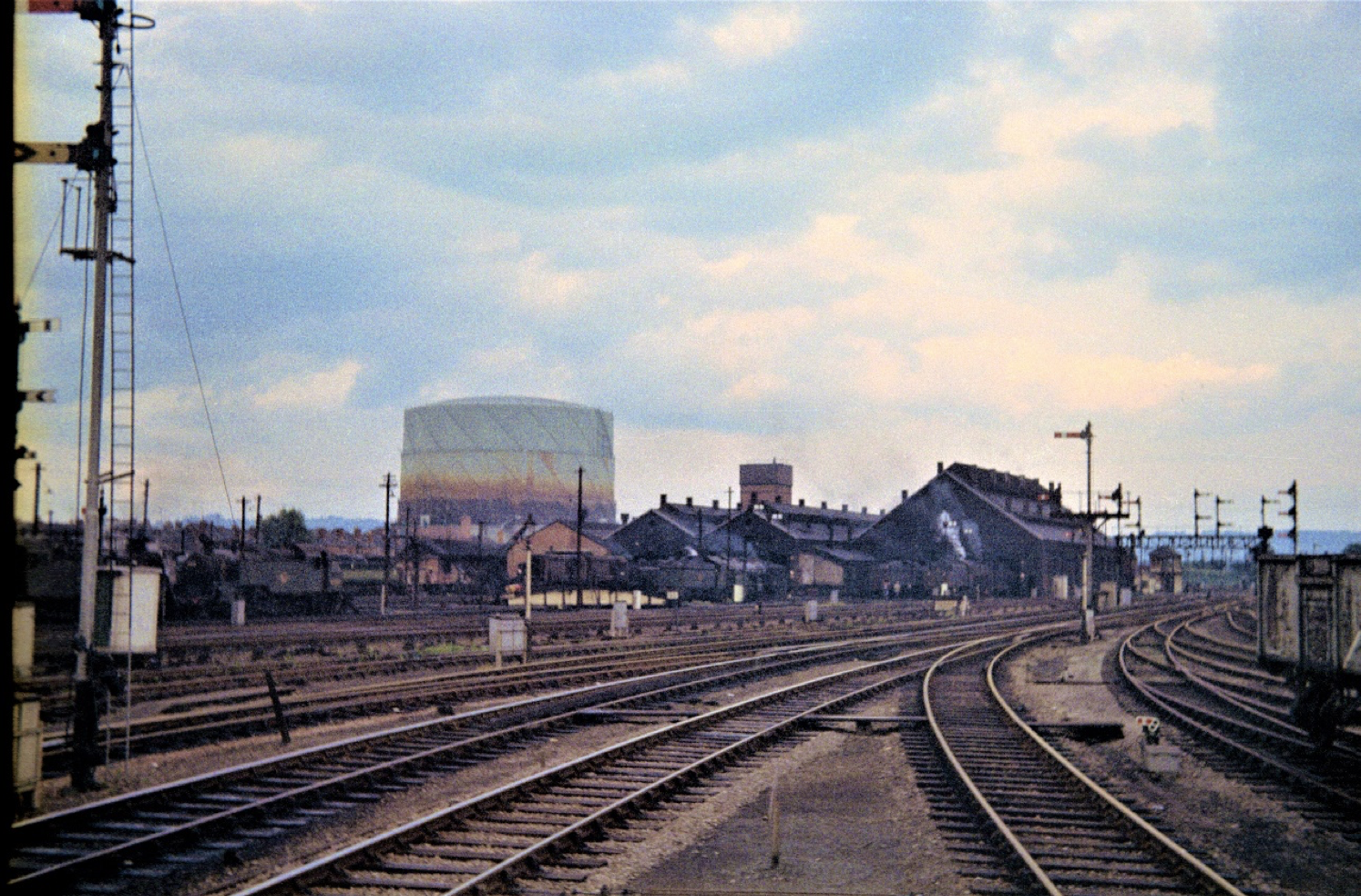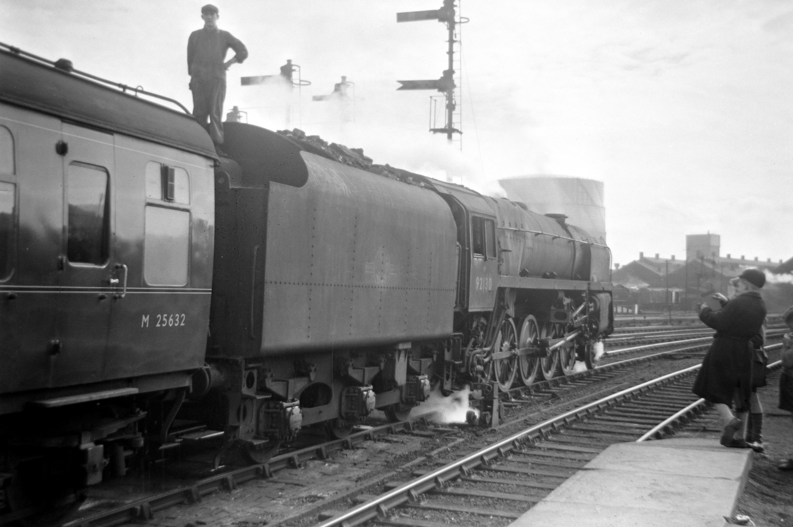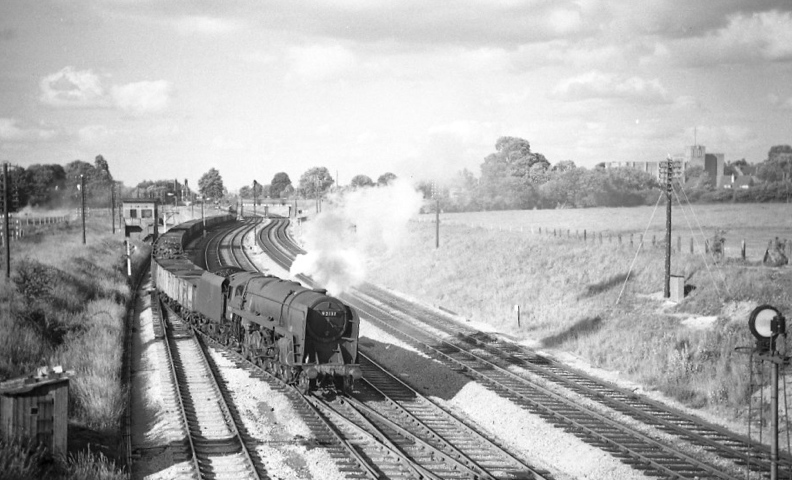1955: The BR Modernisation Plan
The last steam locomotives
One of the first acts of the newly nationalised railway was to put into production a family of modern steam engines incorporating the best design elements of the constituents of the ‘Big Four’, although in fact they were based mainly on LMS practice. The aim was to replace some of the more antiquated and non-standard classes of locomotive, particularly those inherited from pre-1923 constituent companies. From 1951, construction commenced of a range of ‘Standard’ steam loco classes, which were still being built up to 1960. They were built to robust designs adopting modern engineering practices to enable them to operate with reduced maintenance, but despite this, most of these locomotives had short lives.
On a visit to Swindon works on 10 April 1957, Jeff noted a batch of Standard ‘4’ 4-6-0s under construction: Nos. 75059 – 64 for future allocation to Leicester (15C) and Nottingham (16A). Other new classes of locomotive seen at Swindon during this period were Standard ‘3’ 2-6-2Ts (82000 series) and some Caprotti-fitted Standard ‘5’ 4-6-0s. Swindon had also been responsible for the design and construction of the 77000 class ‘3’ 2-6-0s in 1954, which were effectively tender versions of the 82000 tanks. New locomotives were often run-in on turns to Gloucester, but I never saw any of the illusive 77000 class on these workings before they were dispatched to North Eastern and Scottish Regions.
Crewe works were building ‘9F’ 2-10-0s, including a new batch that went to Toton (18A) and Saltley (21A), Nos. 92130-9, which could subsequently be seen when new from May 1957 onwards working the evening Burton (Horninglow) – Bristol fitted freight carrying beer. The first 9F recorded in Gloucester was No. 92045 (18A) on 14 November 1955, and March 1956 TI stated that 18A ‘9Fs’ were now “regularly employed on freight duties to Westerleigh sidings”. By the summer of 1957, 9Fs were being used regularly on summer Saturday extra passenger services. Another batch of new ‘9Fs’ (Nos. 92151-5) was allocated to 21A for fast fitted freight work in early 1958.
An audience of young spotters looks on whilst the fireman tops the tender of ‘9F’ 2-10-0 No. 92130 with water at the advance signal of Gloucester Passenger box, on an up ECS train on 15 April 1959. Activity on Horton Road shed can be seen in the background from the end of Eastgate’s down island platform.
‘9F’ 2-10-0 No. 92131 eases a coal train for Westerleigh off the loop at Tuffley Junction following the passage of a southbound express on a sunny summer’s evening, 18 June 1959.
The Rise of the Diesel
In 1955 British Railways published their Modernisation Plan. The emphasis was on wholesale dieselisation to replace steam locomotion, rather than the alternative of keeping some of the more modern steam locomotives in running order until electrification of major routes could take place. The story of the late fifties and early sixties reflects this fluid situation. The Modernisation Plan included a large construction programme of new diesel locomotives and multiple-units that encompassed the whole range of needs, from shunters to heavy express-passenger and freight locomotives, as well as DMUs. It resulted in a number of private locomotive builders producing a wide variety of designs from which the definitive locomotive designs for the BRB would be derived.
The first lightweight diesel multiple units had entered service in the Leeds area in 1954, but their first manifestation in the Gloucester area was in 1956. By late that year, Swindon carriage works was already dispatching through Gloucester the first Inter-City DMUs, some driving cars of which were built with through corridor connections. They were initially introduced onto Glasgow – Edinburgh services in January 1957, with further units provided for the inauguration, on 17 June 1957, of the Swansea – Birmingham service (in the series W79083/ 79155/ 79440). In March 1956 early Derby-built lightweight units (M79118/ 79633 series) were introduced to the Birmingham – Lichfield suburban service. Some of these units found their way through Gloucester, and on 16 June 1957 Jeff recorded a 10-car formation working an excursion from the Birmingham area to Weston-super-Mare. One would have thought that a journey of over 100 miles aboard one of these units might be rather uncomfortable.
Early 1958 saw Swindon producing another batch of three-car Cross-country DMUs for use on other services in the south-west (W50647/96, 59255 series). However, on 10th March, they took over Birmingham – South Wales duties from the Inter-City DMUs introduced only 9 months earlier. From 13 January, many local services in the Newport and Cardiff Valleys were reorganised also using new Derby 3-car suburban DMUs (W50818/71, 59326 etc).
As mentioned earlier, Gloucester Railway Carriage and Wagon Works were also still involved in new construction for BR. A fleet of 40 2-car DMUs were built for ScR and LMR from summer 1957 (in the series commencing Sc50339/ 56094), the Scottish ones being introduced from 3 February 1958 on Edinburgh local services.
Diesel and electric locomotives were allocated numbers in the 10xxx and 20xxx series respectively under the initial BR numbering scheme, but in 1957 a new system was introduced under which diesels and electrics were identified purely by using a D or E prefix. The first of the new breed of diesel locomotives ordered through the Modernisation Plan, D8000 emerged from English Electric at Newton-le-Willows on 18 June 1957. However, locally the most significant event in late January 1958 was the release of No. D600 Active from the North British Locomotive Works (NBL) in Glasgow, the first of the main-line express diesel-hydraulic ‘Warships’ locomotives ordered for the WR. This engine, and later its four sisters, were run-in on Swindon – Gloucester local trains and caused great excitement initially. They were however destined for Plymouth Laira (83D), so they did not have any immediate impact on the local scene. No. D601 Ark Royal was delivered in March, observed in Gloucester on 8 April 1958, and was working the ‘Cornish Riviera’ by June. They were complemented by the D800 series of hydraulics, under construction at Swindon from May 1957, although the first of the class was not released until 14 July 1958, when No. D800 was named Sir Brian Robertson. NBL Glasgow also produced further D800 ‘Warships’, but they did not start to appear until summer 1960. The first of a further class of ‘type 2’ diesel-hydraulics for the WR in the D6300 series built by NBL appeared in January 1959. Production of this class was slow, and they only started to appear on running-in turns from Swindon in autumn 1959. They later joined their big sisters in Devon and Cornwall (the D6300s were effectively half a D600). By November 1959, passenger services in Devon and Cornwall had been handed over entirely to diesels. However, by 1965 the D600 class was confined to Cornwall working china-clay traffic.
Diesel shunters were also being built in large quantities at a many railway works, Swindon building 204hp shunters in the D2000 series. During June 1958, we recorded a batch of new 350 hp shunters from Derby works in the No. range D3510 upwards coupled inside evening freights ‘dead-in-train’ being delivered to the sheds in the south west (Exeter and Plymouth). In Gloucester, diesel shunters were slow to replace steam engines, but on 28 November 1959 the first appeared: one of the smaller 204hp variety, No. D2123, which was employed on the Over branch, previously the haunt of the spark-arrestor fitted 0-6-0PT No. 1616. Others were subsequently allocated to 85B (Nos. D2137/8 in May 1960) but were soon followed by the arrival of Gloucester’s batch of the larger 350 hp standard shunters (in the No. range D3989-94) from October 1960 onwards.
Passenger rolling-stock
During the nineteen-fifties modernisation came to rolling stock, with Standard coaches forming most of the sets used for express passenger trains. The ex-GW Restaurant Cars in the W9600 series built by Collett in the 1930s that were part of the formation of the Paddington expresses were replaced in around 1960 by RU Standard Unclassified Restaurant Cars in the W1900 series. Similarly, the 12-wheeler Stanier Restaurant Cars used on the ‘Devonian’ and ‘Pines Express’ were replaced by Standard RF Restaurant First Cars in the M300 series by 1961. RMB Buffet Cars in the 1800 series were used on other cross-country express services, and a Griddle Car, M1100, ran regularly in the formation of the 10.28am Derby – Bristol and 5.0pm return from late 1960. More surprisingly, Gresley Buffet-Restaurant Cars such as W9135E were still in use on the Newcastle – Cardiff through service into the late 1960s.
Network proposals
There was also an interesting network development proposal. The November 1957 edition of TI carried the following report: “in connection with the construction of a new spur between the ex-SMJ line and WR Leamington – Banbury route at Fenny Compton, a new marshalling yard is to be built at Churchdown… this will aid schemes to divert through freight traffic from the congested Birmingham area.” (sic.) More than two years later a similar proposal was made for a marshalling yard at Brookthorpe, south of Gloucester, but changes in operating and management as well as the decline in freight traffic meant that neither was ever built, the Brookthorpe proposal being ditched in autumn 1964.


